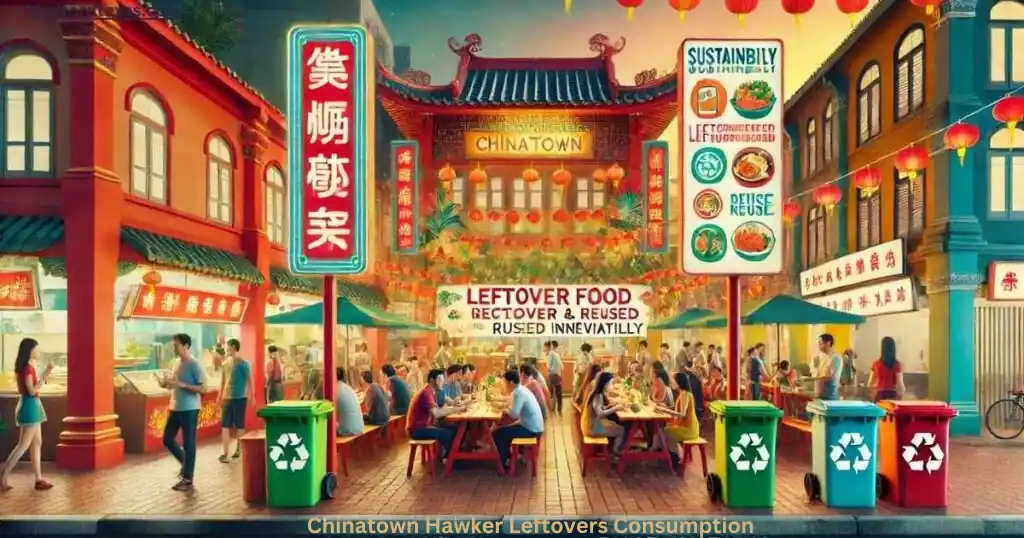Introduction to Chinatown Hawker Leftovers Consumption
Chinatown is a vibrant tapestry of flavors, aromas, and culinary traditions. Among the bustling hawker centers, where locals and tourists alike gather to sample delicious street food, there’s an intriguing practice that many may overlook: the consumption of leftovers. This isn’t just about saving money or reducing waste; it’s a cultural phenomenon steeped in history and community spirit. From late-night snackers to savvy diners looking for value, Chinatown hawker leftovers consumption tells a story of resourcefulness and appreciation for good food. Let’s delve into this fascinating aspect of dining in one of the most beloved neighborhoods around!
The Culture of Leftovers Consumption in Chinatown
Chinatown is a vibrant tapestry of flavors and traditions. Among these, the culture of consuming leftovers stands out as both practical and heartfelt.
For many locals, taking home leftover food from hawker centers is more than just a way to save money. It’s an act that honors the craftsmanship behind each dish. Every bite tells a story of late-night preparations and family recipes handed down through generations.
Sharing leftovers often becomes a communal experience. Families gather around tables filled with half-eaten plates, swapping tastes and memories attached to every morsel.
Moreover, this practice reflects resilience against wastefulness in today’s fast-paced world. Instead of discarding perfectly good food, Chinatown embraces ingenuity by transforming yesterday’s meals into today’s delights.
The aroma wafting from takeaway containers carries nostalgia—remnants of bustling stalls where chefs pour their hearts into every creation.
The Benefits of Eating Leftovers
Eating leftovers is more than a convenient option; it brings numerous advantages. First, it’s economical. You save money by making the most of what you already have.
Leftovers also minimize food waste, which is vital in today’s world. By repurposing meals, you’re actively contributing to sustainability efforts.
In terms of nutrition, many dishes actually taste better the next day. Flavors meld together beautifully as they sit in the fridge.
Additionally, enjoying leftover meals can offer time savings during busy days. With a quick reheat or simple preparation, you can have a satisfying meal ready in minutes.
There’s an element of nostalgia tied to those familiar flavors from yesterday’s feast that often makes them even more enjoyable today.
Safety and Hygiene Concerns
When it comes to Chinatown Hawker leftovers consumption, safety and hygiene are paramount. The bustling environment of hawker centers can sometimes raise concerns about food handling practices.
Many vendors prioritize cleanliness, yet it’s wise for diners to observe conditions. Look for stalls with high turnover; fresh ingredients often indicate proper food management.
Cross-contamination is another aspect worth noting. Make sure utensils and surfaces are clean before indulging in those delightful leftover dishes.
If you’re unsure about the freshness of a meal, trust your instincts. A lingering odor or an unusual texture could signal that it’s best left uneaten.
Consider the time factor—leftovers should ideally be consumed within a few hours to maintain quality and avoid any health risks associated with spoiled food. Awareness goes a long way in ensuring safe dining experiences in these vibrant culinary spaces.
Popular Leftover Dishes in Chinatown Hawker Centers
Chinatown Hawker Centers are a treasure trove of culinary delights, even when it comes to leftovers. One popular dish is the char kway teow, a stir-fried noodle favorite often enjoyed the next day. Its rich flavors meld beautifully over time.
Another must-try is Hainanese chicken rice. The tender chicken and fragrant rice make for an irresistible leftover meal, especially when slathered with chili sauce or ginger paste.
Also noteworthy is bak chor mee—a savory bowl of noodles topped with minced meat and mushrooms that tastes even better on the second day as the flavors deepen.
Don’t forget about curry laksa; its creamy coconut base becomes richer after sitting for a while. Each bite offers a burst of umami that transports you straight back to those bustling hawker stalls.
These dishes embody not just sustenance but also stories shared through each serving of leftovers in Chinatown’s vibrant food scene.
Tips for Enjoying Leftover Meals at Hawker Centers
When you visit a hawker center, make the most of your leftover meals with these handy tips. First, choose dishes that age well. Noodles and curries often taste even better the next day.
Consider portion sizes carefully when ordering. It’s wise to strike a balance between satisfying your hunger and minimizing waste. Share larger platters with friends—this way, leftovers can be enjoyed communally.
Keep an eye on storage conditions if you’re taking food home. Use airtight containers to maintain freshness and prevent spills during transport.
Experiment with reheating methods too! Some dishes thrive in the microwave while others benefit from being warmed on the stove for that just-cooked flavor.
Don’t forget about personalizing leftovers! A squeeze of lime or sprinkle of fresh herbs can elevate yesterday’s meal into something new and delightful.
Read More: New Lanternfly Species Vietnam Cambodia: Unlocking Secrets of Southeast Asian Wildlife
Alternatives to Consuming Leftovers in Chinatown
For those who prefer fresh meals, Chinatown offers a plethora of tempting options. You can explore the vibrant array of stalls serving up made-to-order dishes. From sizzling stir-fries to steaming bowls of noodles, there’s something for everyone.
Many hawker centers also feature daily specials that showcase seasonal ingredients. These dishes highlight the chef’s creativity and keep your palate excited.
If you’re in the mood for lighter fare, consider sampling freshly made dim sum or sushi rolls from local vendors. The taste is often unbeatable compared to leftovers.
Vegetarian and vegan choices abound as well. Try an assortment of vegetable curries or rice paper rolls filled with crisp veggies and herbs for a refreshing change.
Exploring new flavors keeps your dining experience dynamic while celebrating Chinatown’s culinary diversity. Each visit unveils hidden gems waiting to be discovered anew.
Conclusion: Embracing the Tradition of Leftovers in Chinatown Hawker Centers
Chinatown hawker centers are a treasure trove of culinary delights, and the culture surrounding leftovers adds an exciting layer to this vibrant food scene. Embracing Chinatown hawker leftovers consumption not only supports sustainability but also reflects a deep-rooted tradition that celebrates value and resourcefulness.
As you explore the bustling stalls, don’t shy away from those enticing leftover dishes. They carry stories of flavors and community spirit unique to this locale. By savoring these meals, you’re partaking in a rich tapestry woven with heritage and innovation.
Eating leftovers can be more than just satisfying your hunger; it’s about appreciating quality food while minimizing waste. The diverse array of leftover options invites everyone to indulge their palate without breaking the bank or compromising on taste.
So next time you find yourself wandering through the vibrant streets of Chinatown, remember that every morsel tells a story worth tasting. Embrace the habit of enjoying what remains—it’s not just dining; it’s participating in a cherished cultural experience that bridges generations past with present culinary adventures.






Leave a Reply